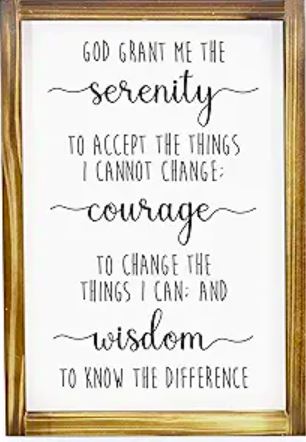
Have you heard of the Serenity Prayer? Many people credit Reinhold Niebuhr with writing it sometime during World War II. It begins “God grant me the serenity to accept the things I cannot change.” It seems to transcend religions and has entered popular culture. You can find it printed on plaques, mugs etc. for better or worse, and it is often seen in a shortened form illustrated above.
It was adopted by Alcoholics Anonymous and other twelve-step programs. I recall it being in Vonnegut’s Slaughterhouse-Five. It was in an interesting film, Rachel Getting Married. It was on an episode of King of the Hill when the school principal asks Hank “Are you familiar with the serenity prayer Hank? Cause this is one of those things I can’t change.”
I’m not concerned about whether or not Reinhold Niebuhr wrote the prayer, and I like that the prayer has been adopted and adapted by others. Every once and awhile, it crosses into my life. I came across a copy of the prayer today on a sheet of paper folded into one of my old journals from late 2001. I know just why it was in there. A bookmark on my life.
I don’t know if you literally bookmark things in your life with paper in a book very often, but we all certainly set bookmarks in our life using objects. I could create a long list of things that bring me back in a flash to a time in my life – books, ticket stubs, a pebble, a record album, a restaurant receipt, airline ticket, vacation souvenirs…
I guess we are more likely to intentionally bookmark the good times in our lives, but I think we also mark the bad times, perhaps unintentionally.
That folded copy of the serenity prayer takes me back to an early winter that was difficult for many people following the events of September 11, 2001. I would have told you then that those events were not the reason that I had crashed into a deep depression, but looking back today, that bookmark reminds me how distorted my perceptions were then.
That piece of paper bookmarks not only the start of a really bad period in my life, but also a very early sign of how I would pull out of that period – a process that took about four years.
I don’t follow the prayer as a life philosophy. I don’t accept all my hardships and just trust that any power or being can make things rights. I firmly believe that you are the most important cause of change in your life. But the first seven lines of the serenity prayer are an approach that I do try to follow.
There are, for me, two parts to the prayer. The first part (minus God) feels almost Buddhist. The second half is more Christian. But I read it as a sonnet – 14 lines of direction, two parallel, but separate paths.
God grant me the serenity
to accept the things I cannot change;
courage to change the things I can;
and wisdom to know the difference.
Living one day at a time;
Enjoying one moment at a time;
Accepting hardships as the pathway to peace;
Taking, as He did, this sinful world
as it is, not as I would have it;
Trusting that He will make all things right
if I surrender to His Will;
That I may be reasonably happy in this life
and supremely happy with Him
Forever in the next.
If all this is not at all in your philosophy, maybe you can connect better with the Calvin and Hobbes comic strip version of the prayer: “Know what I pray for? The strength to change what I can, the inability to accept what I can’t, and the incapacity to tell the difference.”







